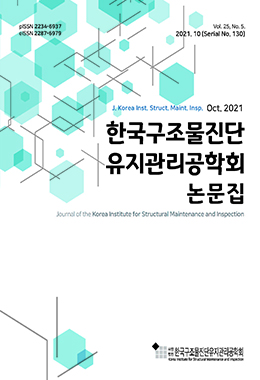국토교통부(2018)의 「필로티 건축물 구조설계 가이드라인」에서는 국내 필로티 형식의 다세대 주택과 같이 중저층의 상부벽식 하부 골조구조를 이루고 있는 복합구조의 고유주기를 안전성을 고려하여 상부 벽식구조에 해당하는 식을 적용하도록 제시하고 있다. 그러나 현행 벽식구조의 고유주기 산정 기준식은 주로 휨 거동하는 고층 벽식구조를 대상으로 한 실측 결과를 통하여 제정된 것으로서 벽체가 전단거동을 하는 국내 4층이하 필로티형 다세대 주택에는 적합하지 않을 것으로 사료되며, 또한, Park et al. (2000)은 해석적 연구를 통하여 10층 이상의 복합구조물의 고유주기에서 하부 골조구조의 영향이 상부 벽식구조보다 크게 작용하고 있음을 확인하였다.
따라서 본 연구에서는 중저층 필로티 구조의 고유주기에 미치는 하부골조의 영향을 검토하기 위하여 상부 벽식구조의 전단 및 휨 강성과 하부 골조구조의 전단강성을 변수로 하는 대상 구조물들에 대하여 유한요소 모델을 이용한 고유치 해석과 고유주기 산정 근사식 그리고 현행 고유주기 산정 기준식을 이용하여 고유주기를 산출하고 비교하였다. 비교결과 하부골조의 전단강성변화가 상부벽체의 휨 또는 전단강성의 변화보다 건물 전체의 고유주기에 더 큰 영향을 주는 것으로 나타났다.
According to the 「Guidelines of Structural Design for Piloti Building」 of the Ministry of Land, Infrastructure and Transport (2018), the natural period of middle and low rise building of upper-walled lower frame type, such as the domestic multiplex house in piloti style, is suggested for safety to apply the existing code formula of the wall structure. However, the current code formula of the wall structure was provided based on actual measurement of high-rise wall-type structures that mainly exhibit bending behavior. So it is considered that it is not suitable for a piloti-type house with four stories or less, where the wall behaves in shear. See also Park et al. (2000) confirmed that the effect of the lower frame part is greater than that of the upper wall part in the natural period of complex structures with 10 or more floors through analytical studies.
Therefore, in this study, in order to examine the effect of the lower frame on the natural period of the middle and low-rise piloti structure, the estimation of natural period by the finite element analysis, approximation formula and ccurrent code formula was performed for the target structures with the shear and flexural stiffness of the upper wall and the shear stiffness of the lower frame as variables. As result, it was found that the change in the shear stiffness of the lower frame had a greater effect on the natural period of the whole building than the change in the bending or shear stiffness of the upper wall.




